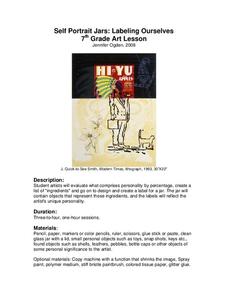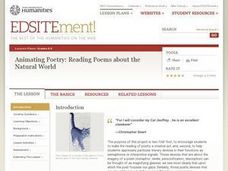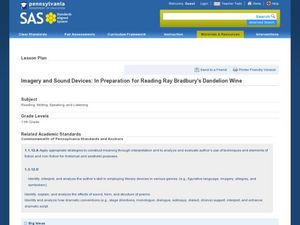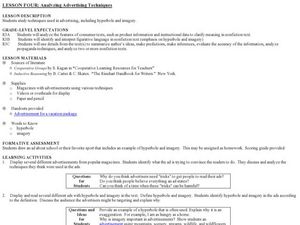Curated OER
Narrative Writing
Fifth graders study narrative writing. In this language arts lesson, 5th graders review how an author uses vivid verbs, imagery, and adjectives to capture reader's attention. Students explore literary devices of foreshadowing, flashback...
Curated OER
Self Portrait Jars: Labeling Ourselves
Seventh graders create an alternative self-portrait. In this art instructional activity students study the artwork of Jaune Quick-to-See Smith. Students use her work as inspiration for a self-portrait in a jar form.
National Endowment for the Humanities
Animating Poetry: Reading Poems about the Natural World
Students complete poetry analysis activities. In this poetry analysis instructional activity, students consider the use of imagery and sound devices in poetry. Students translate poetry into another art, read a diverse selection of...
National Endowment for the Humanities
Seeing Sense in Photographs & Poems
Learners analyze photographs and poetry as forms of each other. In this poetry and photography analysis lesson, high schoolers use the photographs of Alfred Stieglitz and poetry from William Carlos William to explore how poetry and...
Curated OER
Imagery and Sound Devices: In Preparation for Reading Ray Bradbury's Dandelion Wine
Twelfth graders analyze Ray Bradbury's use of techniques and elements of fiction as well as nonfiction in the novel Dandelion Wine. In this novel analysis lesson, 12th graders analyze the sensory techniques in Dandelion Wine. Students...
Curated OER
Symbolism Bookmarks
Students create a bookmark about symbolism. In this literature-based lesson plan, students study the meaning of the word symbolism. Students read and analyze the symbolism found in "The Raven" by Edgar Allen Poe. Then they choose a...
Curated OER
Breaking the Chains: Rising Out of Circumstances
Study history through photographs. In this visual arts and history lesson, students learn to analyze photographs to discover details about life during the Civil War era. Students write journal entries as if they are the African-American...
Curated OER
Poetry-The Essence of Life
Students analyze and appreciate various types of poetry. In this poetry unit, students read classic and contemporary works to discover ways in which poetry expresses strong feelings. Students identify key vocabulary used to analyze...
Curated OER
Color Poems
Students describe colors. In this descriptive writing lesson, students brainstorm color descriptions using all of the senses except sight. Students write poems including similes, sensory images, and interesting word choice. Examples are...
Curated OER
Trees
Students explore tree species based on their features. In this tree lesson, students visit a wooded area and work with a partner to describe distinctive features of trees using all of the senses except "sight." A discovery worksheet is...
Curated OER
Polar Bear Literacy Activity
Students generate vocabulary words synonymous or related to "noise." In this literacy lesson, students listen to the book Polar Bear, Polar Bear, What do You Hear? by Bill Martin and Eric Carle and discuss the meaning of vocabulary words...
Curated OER
Digital Poetry Books
Students, after reviewing the writing process and assessing how to use a digital camera to take creative photos, create a Digital Poetry Book. They incorporate the use of Microsoft Photo Draw and Publisher for the creation of their...
Curated OER
Language Arts: Stylistic Devices
Students are able to define given literary terms, such as metaphor, simile, imagery, personification, symbolism, etc. They are able to identify the use of literary elements in a given text. Students are able to interpret weather...
Curated OER
Language Arts: Awesome Authors Website
Students examine the writing techniques of professional authors and apply them to their own work. In pairs, they email authors to discover the tricks of the trade. Students create their own Website for their work.
Curated OER
A Sense of Place
Learners read "Fish Tale: Falling For a Live One" from The New York Times and discuss the methods and techniques the writer uses to create a strong mental image. Students pick a place in their community they wish to write about and...
Curated OER
"Very tragical mirth:" Romeo and Pyramus, Juliet and Thisbe
Students analyze and compare the poetic tools Shakespeare uses in the death scenes of Romeo and Juliet to those of Pyramus and Thisbe in Midsummer Night's Dream.
Curated OER
Strong Verb Image Makers
Students use description language to clarify ideas and create vivid images in an essay focusing of strong verbs. They discuss weak verbs and explore that the better image the words create, the better the reader understands the text.
Curated OER
Musical Imagery
Learners experience musical imagery. They link this musical concept to literary imagery to gain an understanding of the use of imagery in both genres. After listening to a varriety of sounds, students will compose and perform a melody.
Curated OER
Poetry Elements
Need a quick review of some of the elements of poetry? Eleven key terms are defined and illustrated.
Curated OER
Write, Right
This resource provides the beginning ideas for a instructional activity on writing a narrative. Learners watch a video, identify story elements, including plot and setting, and then write their own stories. If augmented, this...
Curated OER
Our Neighborhood
Students inspect visual arts by analyzing their hometown. In this neighborhood lesson, students identify the different buildings, topography, landmarks and scenery near their home. Students utilize art products such as paints and...
Curated OER
Analyzing Advertising Techniques
High schoolers study hyperbole and imagery in advertising. In this advertising techniques lesson, students identify hyperbole and imagery in print advertisements.
Curated OER
Using Imagery in Poetry
Young scholars examine the use of imagery in poetry. In this literature lesson, students read "Thought of Hanoi," by Nguyen Thi Vinhand use the provided graphic organizer to chart the poem imagery. Young scholars then describe the...
Curated OER
Poetry: What's on Your Plate (Part 2)
Middle schoolers write a short paragraph using strong descriptions. In this using modifiers lesson, students define modifier, adjective, adverb, metaphor, and simile. Middle schoolers then write a journal entry in which they write...

























